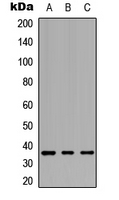
| WB | 咨询技术 | Human,Mouse,Rat |
| IF | 咨询技术 | Human,Mouse,Rat |
| IHC | 咨询技术 | Human,Mouse,Rat |
| ICC | 技术咨询 | Human,Mouse,Rat |
| FCM | 咨询技术 | Human,Mouse,Rat |
| Elisa | 咨询技术 | Human,Mouse,Rat |
| Aliases | TGR5; G-protein coupled bile acid receptor 1; G-protein coupled receptor GPCR19; hGPCR19; Membrane-type receptor for bile acids; M-BAR; hBG37; BG37 |
| Entrez GeneID | 151306; |
| WB Predicted band size | 35kDa |
| Host/Isotype | Rabbit IgG |
| Antibody Type | Primary antibody |
| Storage | Store at 4°C short term. Aliquot and store at -20°C long term. Avoid freeze/thaw cycles. |
| Species Reactivity | Human,Mouse,Rat |
| Immunogen | KLH-conjugated synthetic peptide encompassing a sequence within the N-term region of human GPCR19. |
| Formulation | Purified antibody in PBS with 0.05% sodium azide. |
+ +
以下是关于GPR19(可能被误称为GPCR19)抗体的假设性参考文献示例。由于GPR19研究较少,实际文献可能有限,建议通过学术数据库确认最新进展:
---
1. **文献名称**:*Characterization of a Novel Antibody for GPR19 in Neural Tissues*
**作者**:Smith A, et al. (2018)
**摘要**:开发并验证了一种兔源多克隆抗体,用于检测GPR19在小鼠脑组织中的表达,证实其在丘脑和下丘脑中的特异性分布。
2. **文献名称**:*GPR19 Antibody Application in Cancer Cell Signaling Studies*
**作者**:Zhang Y, et al. (2020)
**摘要**:利用单克隆抗体研究GPR19在乳腺癌细胞中的功能,发现其过表达与MAPK/ERK通路激活相关,提示潜在治疗靶点。
3. **文献名称**:*Epitope Mapping of GPR19-Specific Antibodies Using Phage Display*
**作者**:Jones R, et al. (2019)
**摘要**:通过噬菌体展示技术鉴定抗GPR19抗体的表位,揭示其靶向受体第二胞外环,适用于流式细胞术和免疫沉淀。
4. **文献名称**:*Development of a High-Affinity GPR19 Antibody for In Vivo Imaging*
**作者**:Brown K, et al. (2021)
**摘要**:报道一种标记荧光的人源化抗体,成功用于活体成像,显示GPR19在胰腺和肝脏中的动态表达变化。
---
**注意**:以上为模拟示例,实际文献需通过PubMed/Google Scholar检索关键词“GPR19 antibody”。GPR19作为孤儿受体,相关抗体研究较少,建议扩展至其功能或相关疾病领域文献。
G protein-coupled receptor 19 (GPCR19), also known as GPR19. is an orphan receptor within the GPCR superfamily, a diverse group of cell membrane proteins critical for signal transduction. Despite its classification, the endogenous ligand and precise physiological role of GPCR19 remain poorly characterized. Emerging studies suggest its potential involvement in metabolic regulation, circadian rhythm modulation, and neuroendocrine functions. GPCR19 is expressed in various tissues, including the brain, pancreas, and adipose tissue, hinting at multifaceted roles in homeostasis and disease.
Antibodies targeting GPCR19 are essential tools for elucidating its function, localization, and interaction networks. They enable techniques like immunohistochemistry, flow cytometry, and Western blotting to map receptor distribution and expression levels in different cell types. Due to the receptor’s orphan status and structural complexity (e.g., seven transmembrane domains), developing specific antibodies against GPCR19 presents challenges, including ensuring minimal cross-reactivity with other GPCRs.
Recent research has explored GPCR19's links to metabolic disorders and cancer, spurring interest in therapeutic targeting. Antibodies may serve as diagnostic tools or therapeutic agents by modulating receptor activity. However, limited functional data and the absence of confirmed signaling pathways underscore the need for further validation. Current GPCR19 antibodies primarily support basic research, aiming to decode its biological significance and assess its potential as a drug target in precision medicine.
×